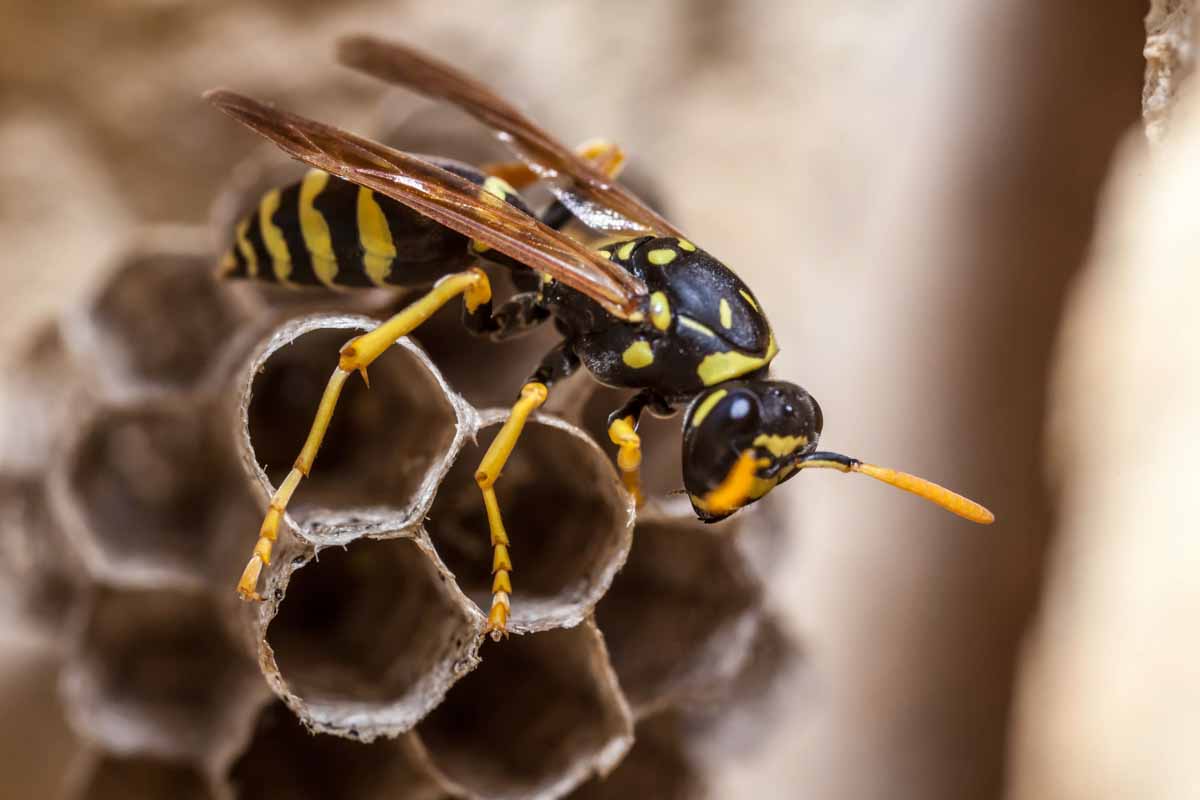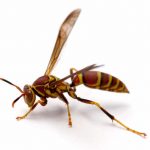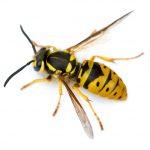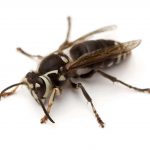Utah Paper Wasps and Their Lookalikes
By Thorn Team • May 5th 2022
When warm weather arrives, it is not unusual to see flying pests around your home or yard. In the case of wasps and other stinging insects, you might be feeling concerned if you're seeing them.

When warm weather arrives, it is not unusual to see flying pests around your home or yard. In the case of wasps and other stinging insects, you might be feeling concerned if you're seeing them.
The good news? Unless you unexpectedly encounter a nest nearby or get too close and cause a stinging insect to feel threatened, most stinging pests won't have any interest in bothering you. After all, they're very busy! Some wasps, however, will sting without much warning.
Identification and control of stinging insects can be tricky. Many of these pests look similar and it can be challenging to get an up-close look. What are the signs of a serious wasp, hornet or yellowjacket issue and how do you tell the difference? What are the best ways to handle an established issue?
Paper Wasps and Other Social Wasps in Utah
The first and most important step in any pest control program is identification. The specific biology of each pest helps determines the best methods of control.
Because identification of stinging insects is tricky given that they're constantly on the move and they like their space, get to know their similarities and differences so you can identify issues without getting too close.
Paper wasps, yellowjackets and hornets are all considered social wasps that live in nests, and unlike bees they can sting multiple times without dying. This makes them a danger if they feel that you are threatening them or their nest.
All social wasps have the following characteristics:
- A distinct waist
- Two pairs of see-through wings
- Three distinct body segments
- Live in hives governed by a caste system
- Create nests from paper (paste made from wood and saliva)
- Capable of stinging repeatedly
Most social wasps are considered a benefit to the environment as they consume various nuisance pests such as spiders and other wasps. Some wasps even help with jobs such as pollination. As annoying as wasps may be, this is important to keep in mind when trying to control them.
First, come to know the differences between foraging activity versus an active nest situation. Wasps use wood fiber and plant matter to make paper for their nests, meaning that they forage these materials from shrubs, trees and plants like the ones around your home.
If you have lots of wasp activity around a specific area of your yard, be on the lookout for a distinct flight path that indicates an active nest.
DEFINITION: A distinct flight path is a direct line of wasps (or bees) coming and going from a distinct spot. If you stand and watch the spot for a length of time, you'll notice insects leaving and flying back from foraging. If you're seeing this activity, the spot you're noticing is almost certainly indicative of the location of a nest.
The most important question? What type of nest are you seeing? This must be explored before treating.
Identifying Paper Wasps
When it comes to the threat of stinging insects, paper wasps are the least of your concerns.
If you are wanting to directly address a wasp issue, the nest needs to be located for simple identification and effective control. As pesky as they can be, seeing wasps in the yard is not enough activity to warrant a treatment.
While paper wasps are still capable of stinging, they are generally considered less aggressive than other types of wasps and will not readily sting. Their nests are smaller than bald-faced hornets or yellowjackets in terms size and number of wasps.
Paper wasp nests are open, hanging nests with an umbrella-like shape. You can see the wasps inside the paper cells of the nest. Paper wasps are commonly found in the following places:
- Eaves of homes or buildings
- Parks (on play equipment or benches)
- Hollow pipes
- In plants and trees
Paper wasps are most confused with yellowjackets, but they have some distinctions that set them apart from other social wasps, including:
- 5/8" to 3/4" in length
- More slender and sloped in shape than a yellowjacket
- Black, brown, red or orange with yellow and markings
- No hairs (like bees do)
- Long legs that dangle while flying
- Open-faced, umbrella shaped paper nests
SOME QUICK ADVICE FROM THORN: There are obvious risks that come with control of stinging insects, especially if you or someone in your vicinity is allergic to stings. Many people would rather hire a local pest control company to address a paper wasp issue, as this is the easiest and lowest risk solution. Some individuals, on the other hand, are set on attempting DIY pest control options first.
If you are in Utah and need professional help with a wasp issue, Thorn will keep you and your loved ones safe from stings.
If you are eager to attempt DIY pest control for wasps, there will be more info on DIY paper wasp control below. Just make sure that the nest you are attempting to control is an open-faced paper wasp nest and not the closed paper nest of a more aggressive pest such as bald-faced hornets or yellowjackets.
Comparing Paper Wasps, Yellowjackets and Bald-Faced Hornets
Paper wasps, yellowjackets and bald-faced hornets are easily confused for each other and should always be approached with caution and proper knowledge.
These three pests are likely the biggest threat you'll face when it comes to spring and summer time stings, and if you want to avoid injury, it's best to know exactly what you're dealing with.
While paper wasps are the least threatening of these pests, they are easily confused with more dangerous lookalikes. In fact, where bees and other wasps are often blamed for stings, around 90% of all stings are caused by yellowjackets as they are most likely to be aggressive when compared to other social wasps.
Yellowjackets are commonly found in underground nests, which can make them especially dangers and easy to stumble into. Their nests are also found in areas such as wall voids and attic spaces. Colonies of yellowjackets can get very large very quickly. Some nests grow to over 10,000 members in one summer season. Yellowjackets enjoy many food sources, but like paper wasps, yellowjackets have a sweet tooth and will sometimes go after ripe fruit.
Bald-faced hornets are not true hornets, they are a type of yellowjacket, but they are more easy-going than yellow jackets and will rarely sting unless they are feeling repeatedly in danger near their nest. This behavior Their nests are most likely found outside in trees, shrubs or bushes but can also be found on buildings and structures from time to time, including eaves and overhangs. As threatening as they may seem, hornets can often be left alone.
Paper Wasps

|
Yellowjackets

|
Bald-faced Hornets

|
Should You Worry About Paper Wasps?
If you're truly dealing with paper wasps, you don't have much to worry about. Other than occasional damage to ripening fruit, paper wasps don't cause damage to property.
While paper wasps may not be as aggressive as other pests, they can still sting, and they can also be a serious nuisance while enjoying time outside in the warm weather.
Paper wasps are attracted to sweet foods and water sources such as ponds, bird baths and pools. While you're living your best life during the spring and summer months, so are paper wasps.
If you have concerns about keeping paper wasps out of your yard, there are a few things you can do to avoid issues, but for active nests hiring a professional is always the least dangerous option.
DIY Control for Paper Wasps and Other Stinging Wasps
When spring arrives, keep your eyes on your eaves. Paper nests that are small and still being constructed under your eaves an easily be scraped off. Addressing these nests in the spring will reduce larger wasp populations come summer. Be careful, as wasps are most likely to feel defensive when their nest is being threatened. A quick tip? Scrape these nests off your eaves at night when wasps are less likely to sting, and all the wasps are in their nest for the evening.
While yellow pheromone traps are commonly used by homeowners and can be placed around the yard in the early spring, these traps are specifically designed to capture yellow jacket queens that have not nested yet. For other stinging pests such as bees, hornets and paper wasps, or if it is no longer springtime, these traps will not be nearly as effective.
To reduce wasp activity around your property, start by taking the following steps:
- If you have plants or fruit trees, pick fruit (including tomatoes) as it ripens and be sure to dispose of any fallen fruit to avoid providing wasps and other pests with food.
- Keep all trash cans closed and make sure to remove any food waste regularly.
- Address any sources of standing water such as ponds, kiddie pools and leaky irrigation hoses.
- Trim back vegetation to reduce nesting habitat.
A Warning About DIY Wasp Treatments
It's no secret that wasp killer can be purchased at the hardware store. It's also no secret that wasp treatments can be seriously dangerous, especially for people who are allergic to stings. Over-the-counter wasp products need to be used very carefully and in tandem with proper PPE (personal protective equipment).
Be cautious. Wasp sprays available for purchase at the store are repellant products. They are easily detected by wasps and can be incredibly agitating to the nest. This greatly increases the risk of being stung while treating.
Since over-the-counter wasp killer is a contact insecticide, it must come in contact with wasps (including the queen) to do its job. This makes DIY wasp treatment a viable option in a paper wasp situation, but only for paper wasps with an open nest. Paper wasps are less aggressive, and their open nests provide the opportunity to treat the queen. Closed nests contain more aggressive stinging pests and should be handled by a professional.
For DIY paper wasp treatment, have the following equipment and tools handy:
- Pressurized wasp killer that allows you to stay at a distance
- A bee veil and suit, including gloves
- Long, thick pants
- Long sleeves
- A ladder (if needed)
Wasp Control in Utah
Whether you're dealing with paper wasps, yellowjackets or bald-faced hornets, Thorn is here to help keep you and your loved ones safe so you can enjoy the warm weather fun free of worries.
If you're located in Utah and you're concerned about a wasp nest on your property, we can help! Send us a picture and a quick message describing the activity you're seeing, and we'll get you taken care of as quickly as possible.
About Thorn
Thorn is a Utah local pest management company. We are a QualityPro certified company which is a prestigious accreditation awarded to less than 3% of the pest management companies in the US.
Resources
About Thorn
Thorn is a Utah local pest management company. We are a QualityPro certified company which is a prestigious accreditation awarded to less than 3% of the pest management companies in the US.